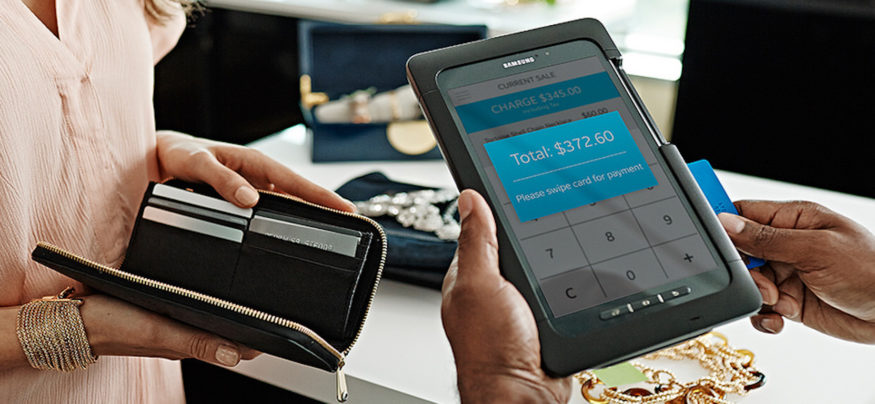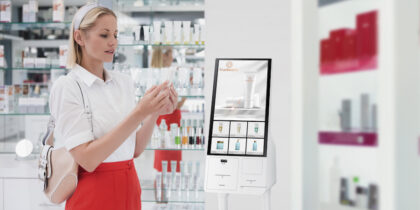The center of the universe for most consumers these days is their smartphone — a device so deeply attached to their lifestyles that it gets a place on a lot of bedside tables at night.
Smartphones are invariably with us when we shop — a dynamic that small business retailers are trying to understand and leverage. But in-store mobile shopping can pose a threat through “showrooming” — the phenomenon of shoppers using smartphones in-store to research competitor pricing, and ultimately leaving without making a purchase.
In-store mobile shopping is also an opportunity. Deloitte suggests that digitally-savvy consumers buy and spend more in stores, converting at a 20 percent higher rate than people who don’t use digital as a tool in their shopping process.
Here are three ways that small businesses can leverage all those smartphones coming into their stores, and how they can use effective tools like digital displays to their advantage.
Driving Awareness
You spent the money to get an app built for your store or small chain, or you had a mobile version of your website put together. Maybe you partnered with a loyalty or rewards app service to incentivize shoppers with points and awards. So how do you let people know those services and tools exist?
The usual tactics are tent cards and window stickers. But chances are, they’re not really getting noticed, and if they are, there’s just enough marketing space to tell people that the apps or tools even exist. But put that information on digital signs in stores, and it’s a very different story.
First, the larger visual footprint and moving elements attract eyeballs. Second, there’s space to effectively communicate these apps’ value to shoppers, how they can get the apps on their phones and how to use them. Third, technologies like QR codes and near field communication (NFC) tags allow users to take additional information away from displays and store it on their phones.
Finally, emerging technologies are bridging the divide between the displays in consumers’ hands and those in stores. There are now multiple ways for someone with a smartphone to directly interact with screens in stores — whether that’s to play games or to launch and control smartphone content from a much larger display.
That probably sounds complicated and expensive, but web- and cloud-based services have democratized these technologies. What was once only affordable and available to the largest retailers is now something almost any shop on Main Street can apply.
Going Social
Endless research has validated the value of peer reviews and endorsements — whether that’s the written summary of a restaurant meal and experience, or photos of happy customers showing off new outfits.
Social media tools like Facebook, Pinterest, Instagram, Twitter and many others all have the power to generate content from smartphones in stores to create endorsements and excitement about that small business. Many digital signage software platforms have simple tools that enable small business operators to curate and push high-impact social visuals to in-store screens in seconds.
A customer might routinely show off images of their latest fashion finds to their friends and followers on social channels, and smart retailers are grabbing that content for their own uses. The premium department store retailer Nordstrom, for example, makes Pinterest pins a fun, interactive part of displays.
But it’s not just about dresses, shoes and handbags. A fishing outfitter, for example, could make great use of the inevitable “Look what I reeled in!” shots on the dock from happy customers.
The good news is that between cloud-based software platforms and easily deployed and managed digital signage systems, getting social media on screens has only modest budget and resource implications.
Harnessing Shopper Intelligence
Savvy smartphone users keep data bills in check by using Wi-Fi from local businesses. It’s a great perk with which to bring people in, but it’s also an intriguing new tool to help retailers understand shopper behaviors and interests.
Companies have emerged offering retail analytics platforms that anonymously track and log consumers through their smartphones. These technologies log and track unique identifiers for each phone with Wi-Fi enabled that comes into a defined area. All those records roll up into reports, charts and visuals that reflect what’s really happening in a store.
These analytics systems can show the busy spots in stores, how long people dwell, slow and busy times and a wealth of other information that was formerly available only to the largest retailers. Some digital signage platforms are using that data to dynamically show content based on these patterns.
Realizing Mobile’s Opportunity
Smartphones are transforming businesses large and small. What’s constant in all that change is the consumer expectation for more information and a better experience. Digital signage helps to deliver on that.





